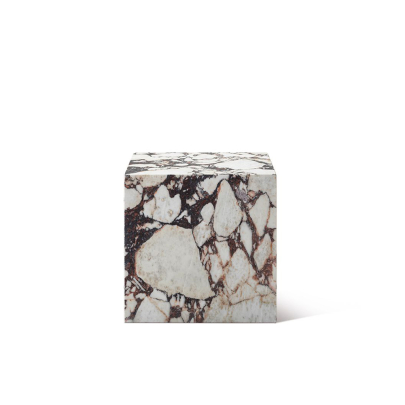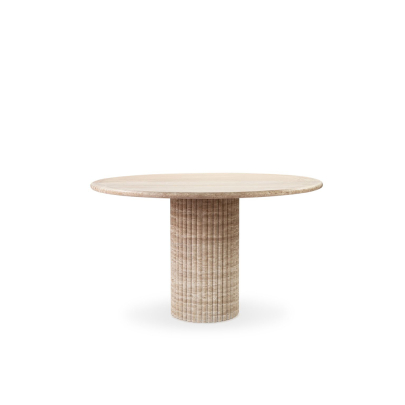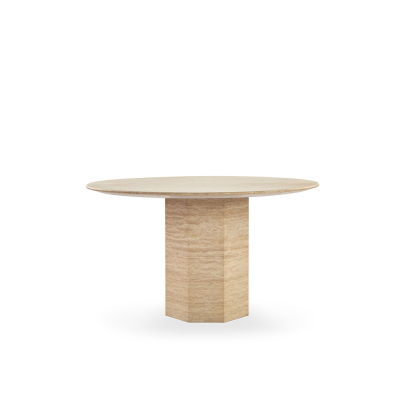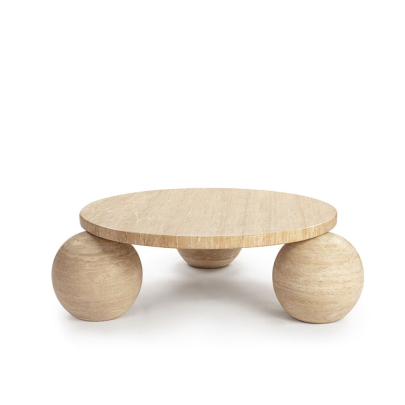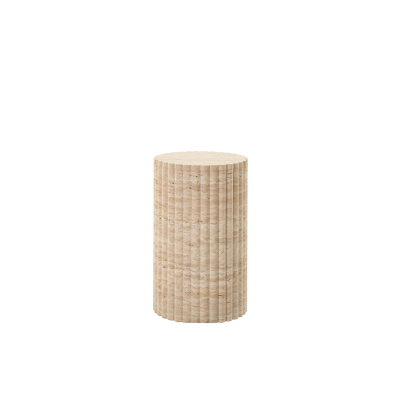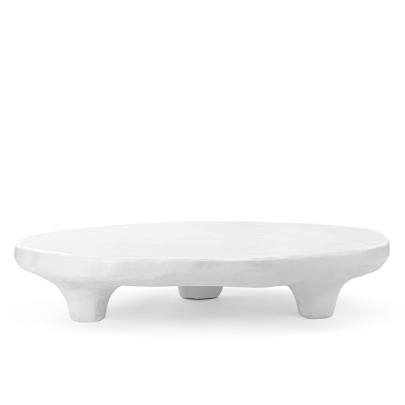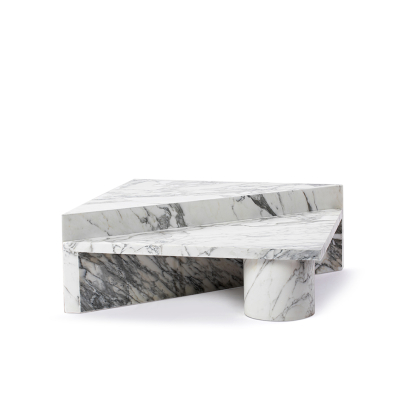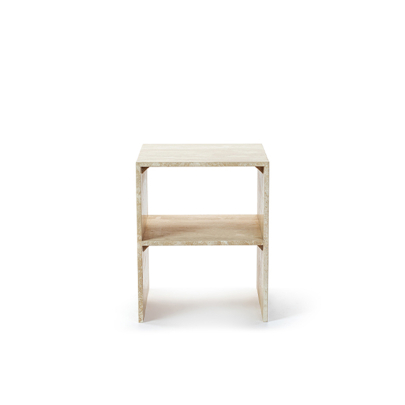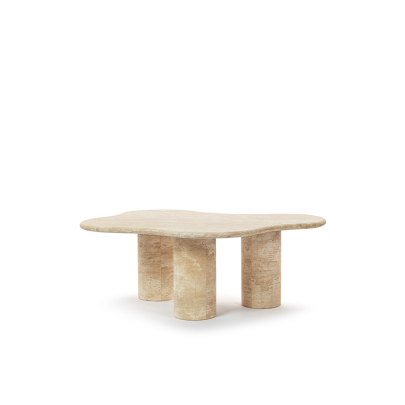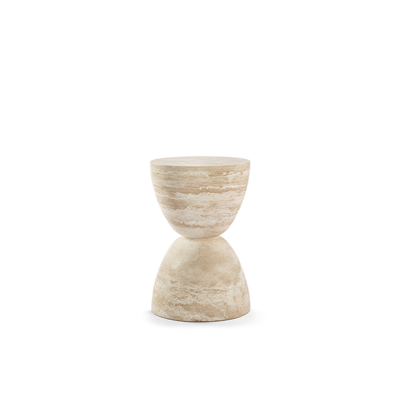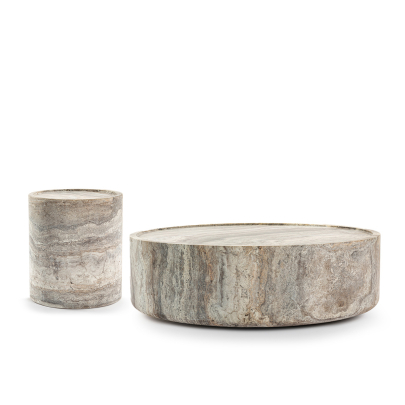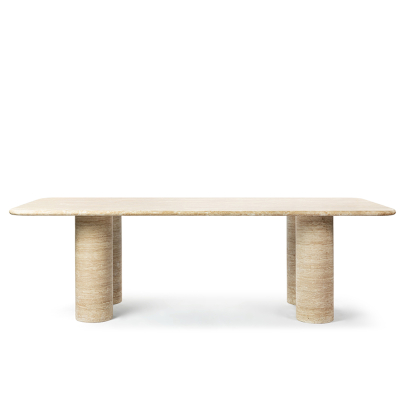
It's very important to know how to wash a weighted blanket as you can ruin it otherwise.
Over the course of the last few months, especially after the pandemic, the need for comfy spaces has skyrocketed. People who used to love the clean austerity of the modern style now prefer soft surfaces, relaxed silhouette furniture like the sherpa Pelican Chair, and comfortable decor.
Now that we spend most of our time indoors, sleek and edgy spaces have become hard to swallow. We want to make each space personal now, whether it's introducing a cozy Womb Chair replica or decorating with fun organic elements like the Wicker Bench.
The need to evoke coziness in every single aspect of the home has become overwhelming, which is why more and more people are leaning towards plush, cozy, textures, be it a comfy mid-century modern sectional like the curvy Mario Bellini Sofa or plush EM Sky Sofa, and especially, most importantly: weighted blankets.
So, what exactly is a weighted blanket?
It's actually a heavy blanket that was designed to mimic the OT technique called deep touch.It helps reduce anxiety, helps a person sleep better, and utilizes the concept of deep touch therapy which indicates that putting gentle pressure on the body can release serotonin the happy chemical of the brain.
Essentially, this blanket is perfect for invoking a sense of calm, coziness, and well-being within the body. It's like being embraced in a warm hug while you're lying down on your bed.
Benefits of a Weighted Blanket
There are many benefits of a weighted blanket, and if you constantly suffer through sleep anxiety and insomnia, you'll really appreciate them. It's important to what you'll be gaining before looking at how you can maintain and wash a weighted blanket. Let's take a look:


A sense of security: a weighted blanket provides a sense of security to the mind and body, releasing oxytocin in the brain, which can calm you down and cause you to ease into comfortable sleep.
Calms the mind: the production of serotonin and dopamine are related to deep pressure therapy that this blanket invokes. Both chemicals make you feel calm and stave off anxiety.
Battle insomnia: it is a scientifically proven fact that weighted blankets help battle insomnia. Multiple studies have led psychologists to conclude that the light touch sensation of these blankets leads to improve the sleep quality of the user.
Eases pain and helps in other medical conditions: a weighted blanket can help you fight off or lighten the pain of other medical conditions such as fibromyalgia. It may also help relieve dental pain and generally makes you feel very grounded and relaxed.
Happy and stress-free: a weighted blanket is a great way to reduce your stress and get a good night's sleep, making you feel happy and stress-free in the long run.
Improved focus: This type of blanket helps improve focus in both children as well as adults by using it during day time.
Types of Weighted Blanket
As a thumb rule, a weighted blanket should weigh around 10% 12% of the user's body weight for the best effect. It's also best to keep away from oversized ones because they can make you feel suffocated.
There are actually many types of weighted blankets. They're categorized based on their fabric, manufacturing, and filling. It's important to consider all of them before determining how to wash your weighted blanket. Let's take a look at all of them:
Types of fillings
Filler is basically the material that lends weight to such blankets. They're usually inserted into small pockets stitched all over the blanket for even distribution of weight. These are the types of fillings that are usually available in weighted blankets:


Plastic pellets: Made out of polypropylene, this flexible material is usually sewn into the fabric and contours well against the users body. You just need to ensure that you're choosing a non-toxic option.
Micro glass beads: Resembling salt crystals, these beads are one of the more expensive filler options for a weighted blanket. They are also eco-friendly and hypoallergenic. They're also heavier than plastic pellets and are a great option for people who want extensive deep touch therapy.
Steel shot beads: Even larger than glass beads, these beads are perfect for enhancing the weight of your blanket for a calming effect. They are very durable and don't pose a threat when you're washing your weighted blanket. However, they may slip out of the seams of a blanket that hasn't been stitched well.
Smooth pebbles and river stones: Another common filling material for a weighted blanket includes smooth pebbles and river stones. They're usually used in DIY blankets and you need to ensure that they've completely dried up because even a bit of moisture can cause mold.
(Notes: Other DIY filling materials include sand and grains like rice and beans!)
Types of covering
The top layer of a weighted blanket is called a covering. It's also made out of different materials depending on your needs and your preference for a particular surface. Here are the most common options:
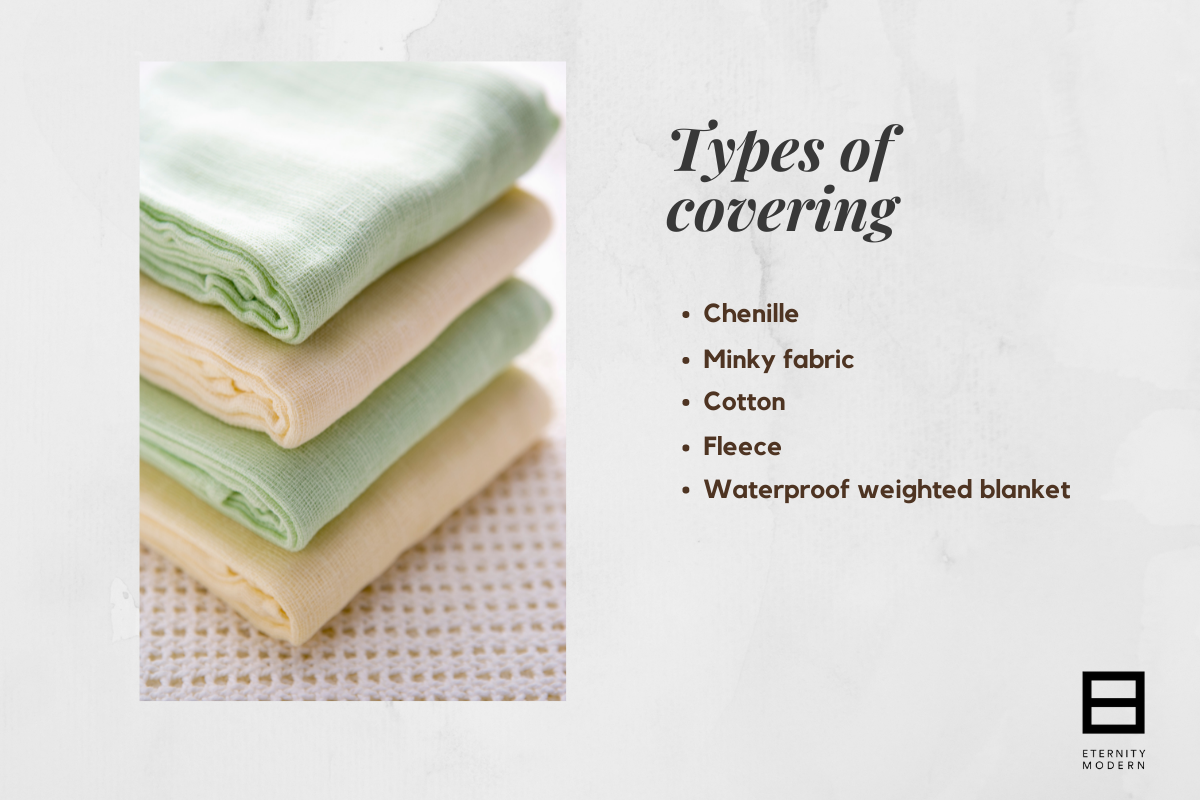

Chenille: This soft, fluffy fabric is one of the comfiest ones that you can opt for. This fabric is known for its gentle comfort and really works on people who're suffering from constant stress and anxiety.
Minky fabric: This plush fabric has a short fiber and is very smooth to the touch almost, but not quite like silk. It's a great choice for people whose body temperature runs on the colder side or who live in cold regions.
Cotton: Weighted blankets made out of cotton fabric are very versatile and breathable. They don't make the users body feel hot even when the weight of the blanket applies gentle pressure to the whole body.
Fleece: Fleece coverings are great for people who suffer from sensory setbacks and autism. It's super luxe and perfect for applying deep touch therapy. It's very durable and great for everyday use.
Waterproof weighted blanket: This type of a blanket is water and fire resistant. It's also antimicrobial. All the water vapor and heat evaporates from the blanket, allowing the users body to maintain a good, balanced temperature inside.
Basic Ways of Washing A Weighted Blanket
It's very important to know the correct way on how to wash a weighted blanket. Here are some basic considerations to know before you take on this venture:
For machine washing
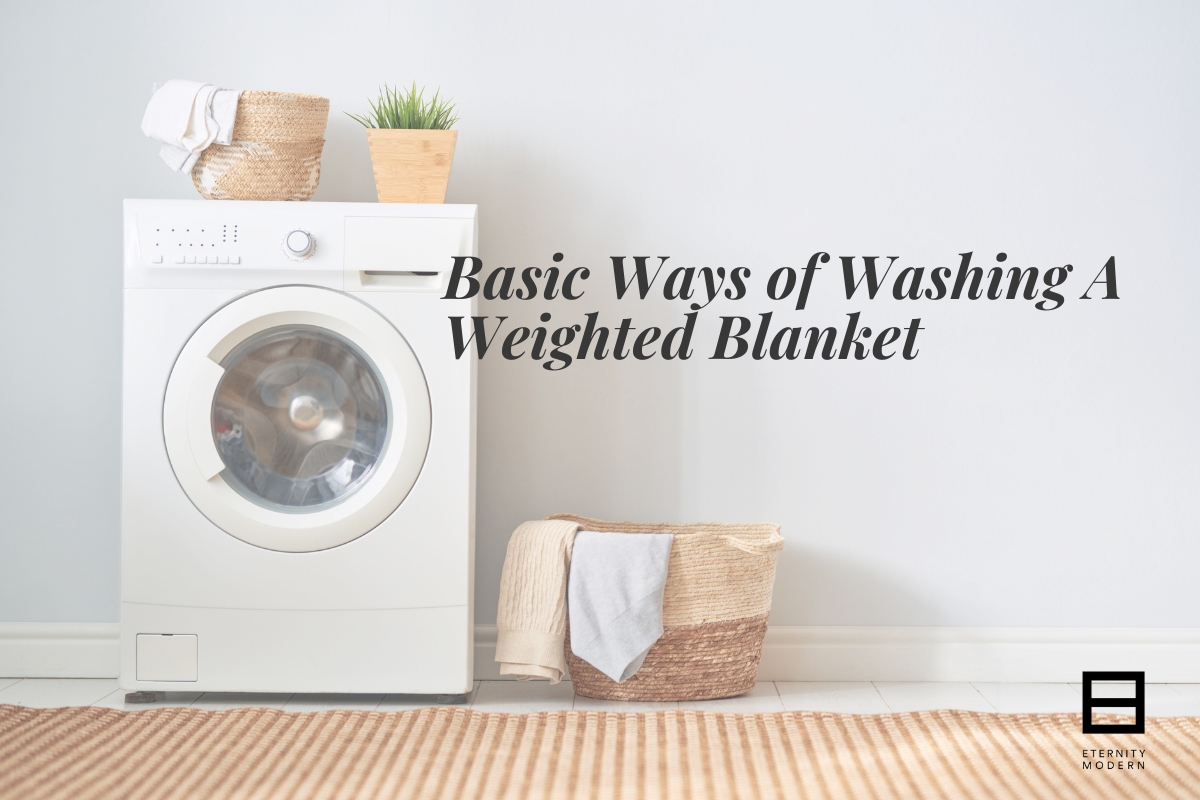

It's important to know the weight-limit of your machine before you stuff the blanket in. many machines have a certain weight limit and your blanket might exceed those.
If your blanket's weight exceeds your washing machine's load limit, then you need to hand wash it.
While it is generally advisable for weighted blankets to be washed in cold water, you should wash the ones with poly pellets and glass bead fillings with warm water.
Do not use hot water, as it can damage your blanket.
You shouldn't use bleach or other fabric softeners at all, as they can damage or gel the fibers of your blanket together.
It's important to set your washing machine settings to a low, gentle cycle, otherwise your filler and covers might get ruined. A fast cycle doesn't sit well with the machine's motor.
(Note: usually, commercial grade machines at larger Laundromats are suitable for washing and drying such blankets because they have much more room and better settings to accommodate such blankets.)
For hand washing


Hand washing a weighted blanket can be a laborious task, so you better be prepared for it.
You'll actually need a large tub (large enough to accommodate your blanket). It should also have room for an extra layer of water when the blanket has been submerged in it.
You can use an appropriate amount of detergent, but no bleach or fabric softeners!
It's best if you soak the whole blanket in the tub for a few minutes so all the stains and bodily fluids can ease out of the cover.
The process of kneading and rinsing can be hard because of the weight of the blanket, but you need to do it properly so that all the detergent can be rinsed out.
Weighted blankets should be air dried. Do not wring them to drain excess water as this can cause wrinkles and wearing to appear on your blanket's surface.
Just let it air dry (away from the sun, preferably in filtered light to avoid fading) and let the material absorb any excess water!
Basic Considerations of Washing A Weighted Blanket
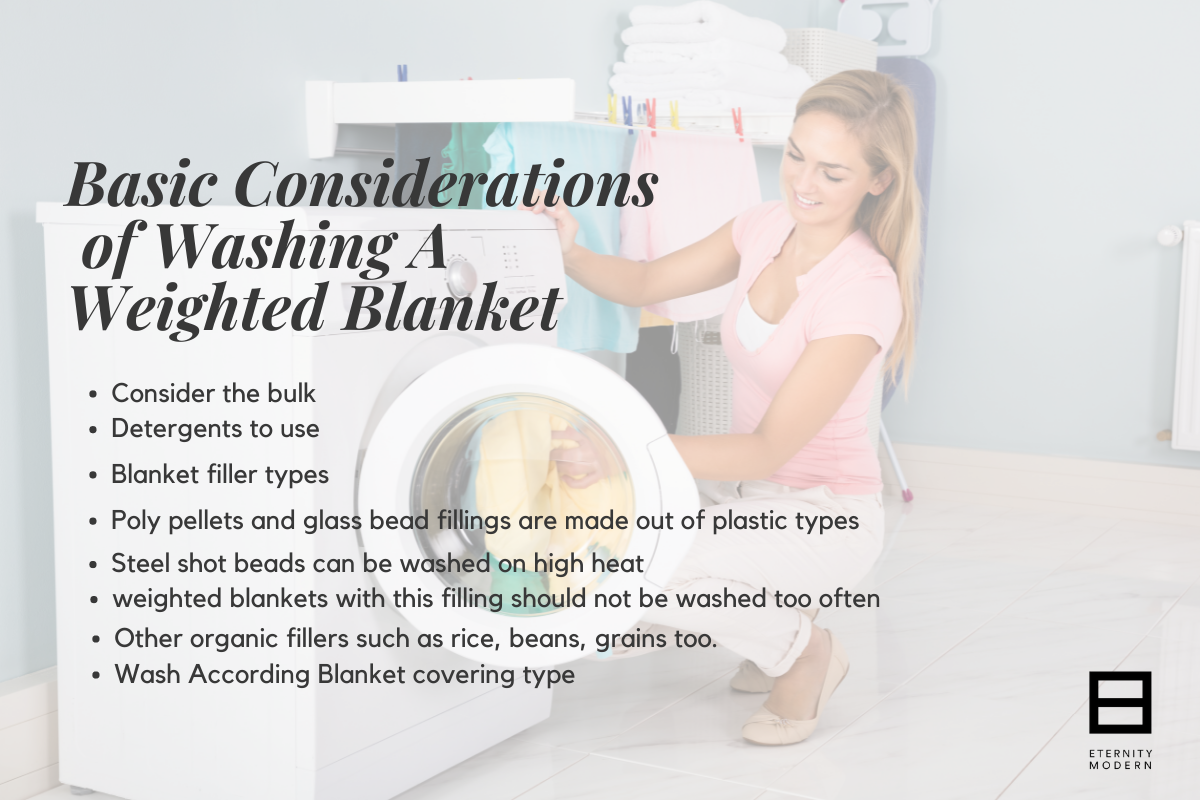

Consider the bulk: Ideally, your blanket should weigh less than 20lbs for it to be machine washed. Other than that, if you don't have a front-facing washing machine, it's best to consider a Laundromat. You should also carefully check your machine's bearable load before stuffing the blanket inside it.
Detergents to use: Professionals suggest that you should use non-chemical liquid detergents to wash this blanket. Chemical products such as bleach or softeners should be avoided at all costs.
Blanket filler types: The filling of your weighted blanket determines how it should be washed. Let's take a look at the different considerations on this matter.
Poly pellets and glass bead fillings are made out of plastic, so it's best that you don't wash them on high heat, as it may damage them or make them clump. Use either gentle warm or neutral water.
Steel shot beads can be washed on high heat, but you should make sure that your washing machine can handle the extra weight of this blanket.
As for sand, weighted blankets with this filling should not be washed too often, as the sand can actually expand when exposed to water and may even clump together if not dried properly. Washing it may even cause uneven distribution of weight.
Similarly, other organic fillers such as rice, beans, grains, etc. are also not good for washing as water causes them to become soggy. They may even decompose or garner an infestation.
Blanket covering type: Just like the filling, the covering of your weighted blanket also matters when it comes to how you should wash it. Here're some considerations for you:
Cotton coverings are very easy to wash. Just make sure you don't spin them on heat more than 50 degrees, as it may cause the fabric to shrink. Similarly, sun drying and tumbling can also cause it to shrink.
Minky is easy to wash, and you should spot clean any stains before washing it entirely. Make sure to use non-chemical cleaners and wash it in cool water.
Fleece should also be pre-treated and you should also soak it in water for a few minutes beforehand to soften the stains. It should be washed in warm water and you should wash it alone because other fabrics can cause abrasion on its surface.
How to cut-down weighted blanket washing frequency
Since weighted blankets can be super hard to wash, it's important that you cut-down their washing frequency. Here are some handy tips on how you can do so:
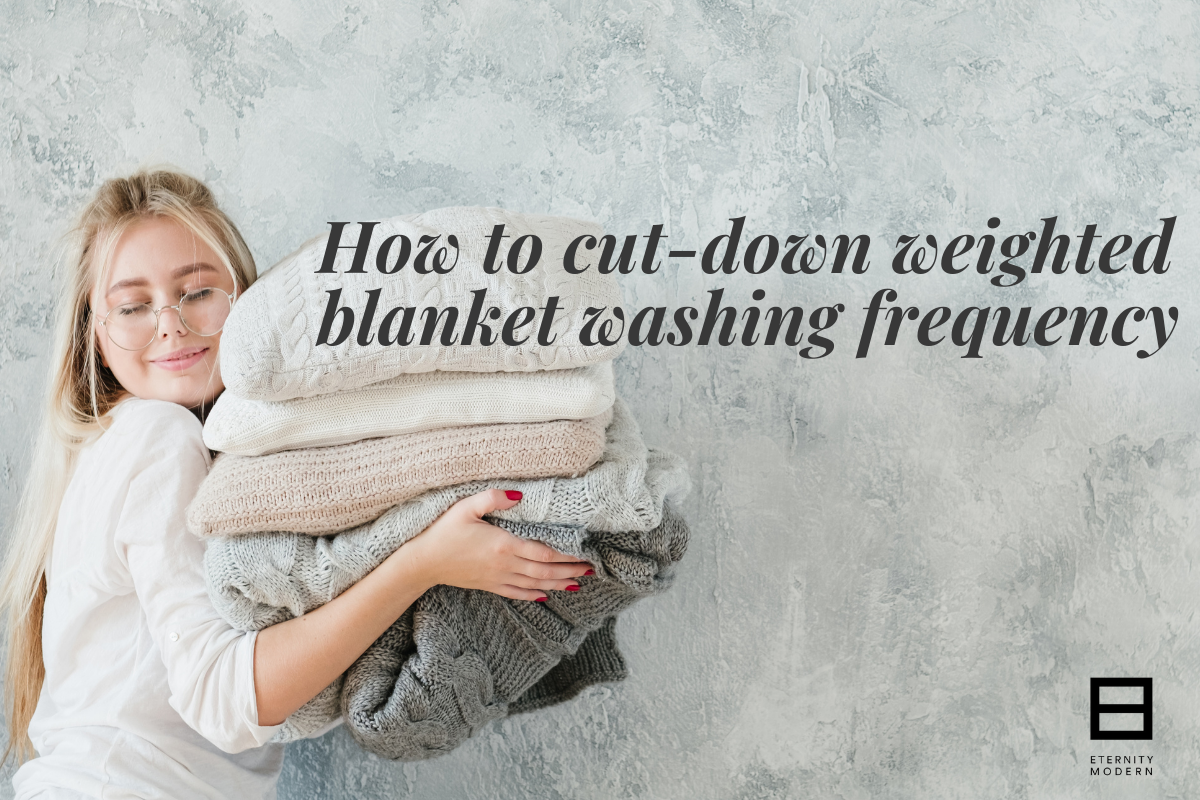

There are some weighted blankets that come with removable duvet covers. You can just take them off, wash the cover and let the filling be.
A weighted blanket should not be used as a bedspread accessory. It's a therapeutic tool to help calm a distressed person. So when it's not in use, you should just fold it up and put it away.
Weighted blankets are therapeutic tools, so it's best to keep them away from pets if you can. Animals tend to shed and they can even leave paw prints on the covers. Sometimes, they also smell. This may exacerbate the need to wash the blanket.
Taking meals within or on your weighted blanket can cause inadvertent staining. It may also make your cause food smells to seep into your blanket surface.
A good way to avoid a full on wash is to spot clean. This basically means that you should treat the small stains and spots on your blanket separately. If they can be removed that way, then it'll help you avoid fully washing the whole thing.
Important tips for washing a weighted blanket
Since a weighted blanket is an expensive investment, it's important to take care of it. washing it wrong can lead to disastrous effects, so it's best to know every single thing before you take on this venture. Here are some important tips on how to wash a weighted blanket:
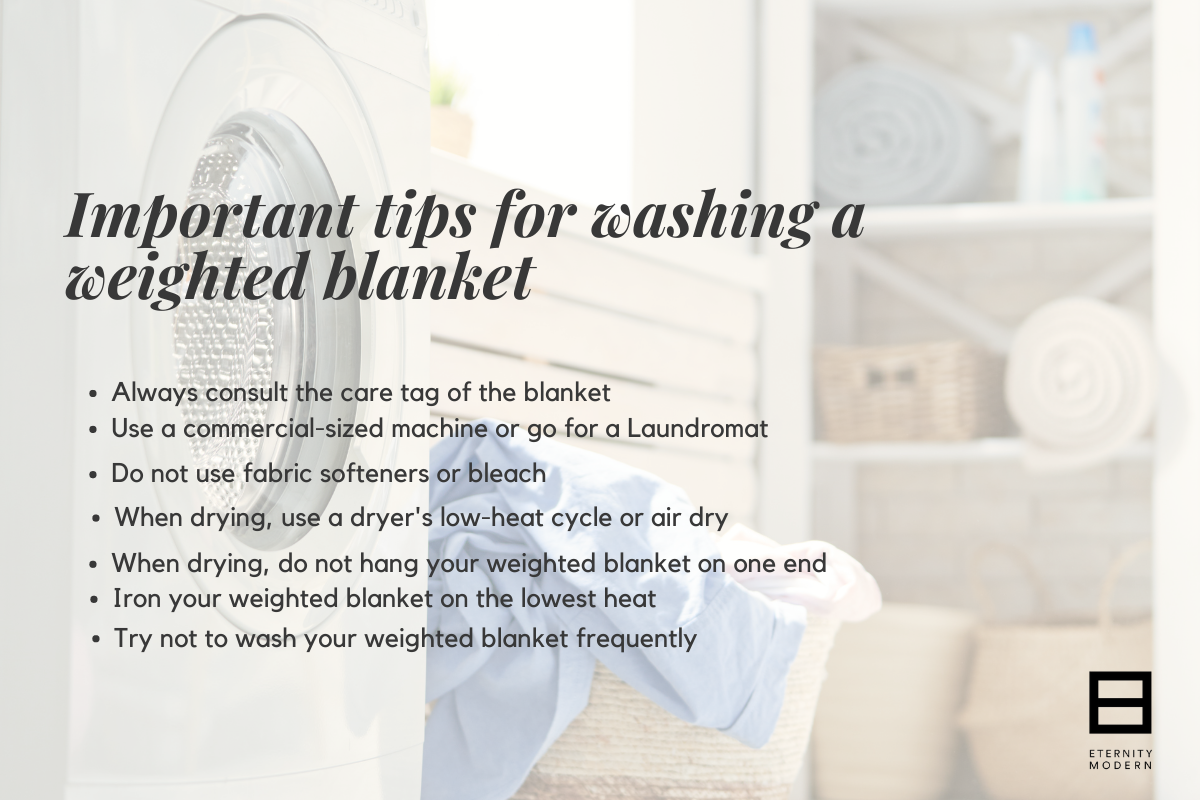

Always consult the care tag of the blanket: Since there are several types of weighted blanket fillings and covers (and not all of them are washable) it's always recommended to carefully read the care tag of your blanket. It will tell you exactly how to clean your blanket without damaging it. For example, a sand blanket will have different care instructions than a glass bead one. Similarly, a cotton and a minky blanket will have varying care instructions. Follow the instructions carefully and do not stray from them.
Use a commercial-sized machine or go for a Laundromat: the size of your washing machine is really important. As most weighted blankets exceed the weight capacity of the blanket's bulk, it's recommended to use a commercial grade Laundromat washing machine instead. It's front facing, can handle the bulk of the blanket, and can be easily operated. Hand washing is also recommended, but it can be quite an overwhelming task.
Do not use fabric softeners or bleach: The cover and filling of a weighted blanket are two parts of a whole. Both of them are highly important, and while some covering materials can handle limited spot cleaning with chemical cleaners, the filling simply cannot. The chemicals in softeners and bleach may end up ruining the filling inside. For plastic fillers, it may gel them together, and for others, the harshness will definitely ruin the overall softness. It may even damage the quality of the fibers.
When drying, use a dryer's low-heat cycle or air dry: if your weighted blanket has sand or plastic filler components, then you should never wash or dry it on high heat. It may end up clumping the filling. Instead, either put it on a low-heat cycle or let the whole thing air dry. With the latter, the filling will just absorb the water, though it may take longer.
When drying, do not hang your weighted blanket on one end: It is recommended to hang your weighted blanket on one end, as it may cause it to lose its shape. In fact, you should give it a good shake so that the filler can maintain its even distribution inside.
Iron your weighted blanket on the lowest heat: It is best to avoid ironing your weighted blanket, but if the wrinkles bother you too much, then choose the lowest heat on your iron. Otherwise, the plastic or glass bead filling may end up melting inside.
Try not to wash your weighted blanket frequently: washing such blankets too often can not only damage your machine, but also the blanket itself. You may find fraying edges and uneven distribution of the filling if you do it too often. Try to stick to spot cleaning in case of spills or stains. Other than that, try to opt for a blanket that has a removable cover, so that you won't have to wash the filling to begin with!
This is everything that you need to know about weighted blankets, why they are so popular, and how you can wash them. We hope you find this guide helpful and determine the best way to give your own blanket a good wash!

